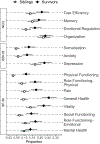Risk factors for neurocognitive impairment, emotional distress, and poor quality of life in survivors of pediatric rhabdomyosarcoma: A report from the Childhood Cancer Survivor Study
- PMID: 38373075
- PMCID: PMC11139574
- DOI: 10.1002/cncr.35236
Risk factors for neurocognitive impairment, emotional distress, and poor quality of life in survivors of pediatric rhabdomyosarcoma: A report from the Childhood Cancer Survivor Study
Abstract
Background: Prevalence and risk of poor psychological outcomes following rhabdomyosarcoma (RMS) are not well-established.
Methods: Participants in this cross-sectional, case-control study (n = 713 survivors, 42.5% female; mean [SD] age, 30.5 [6.6] years; n = 706 siblings, 57.2% female; mean age, 32.8,[7.9] years) completed measures of neurocognition, emotional distress, and health-related quality of life (HRQOL). Multivariable logistic regression models identified treatments, health behaviors, and chronic conditions associated with impairment.
Results: Relative to siblings, more survivors reported neurocognitive impairment (task efficiency: 21.1% vs. 13.7%, emotional regulation: 16.7% vs. 11.0%, memory: 19.3% vs. 15.1%), elevated emotional distress (somatic distress: 12.9% vs. 4.7%, anxiety: 11.7% vs. 5.9%, depression: 22.8% vs. 16.9%) and poorer HRQOL (physical functioning: 11.1% vs. 2.8%, role functioning due to physical problems: 16.8% vs. 8.2%, pain: 17.5% vs. 10.0%, vitality: 22.3% vs. 13.8%, social functioning: 14.4% vs. 6.8%, emotional functioning: 17.1% vs. 10.6%). Cranial radiation increased risk for impaired task efficiency (odds ratio [OR], 2.30; 95% confidence interval [CI], 1.14-4.63), whereas chest and pelvic radiation predicted increased risk of physical functioning (OR, 2.68; 95% CI, 1.16-6.21 and OR, 3.44; 95% CI, 1.70-6.95, respectively). Smoking was associated with impaired task efficiency (OR, 2.06; 95% CI, 1.14-3.70), memory (OR, 2.23; 95% CI, 1.26-3.95), anxiety (OR, 2.71; 95% CI, 1.36-5.41) and depression (OR, 1.77; 95% CI, 1.01-3.11). Neurologic conditions increased risk of anxiety (OR, 2.30; 95% CI, 1.04-5.10), and hearing conditions increased risk of depression (OR, 1.79; 95% CI, 1.05-3.03). Neurologic and hearing conditions, respectively, were associated with impaired memory (OR, 2.44; 95% CI, 1.20-4.95 and OR, 1.87; 95% CI, 1.05-3.35) and poor health perception (OR, 2.62; 95% CI, 1.62-1.28 and OR, 2.33; 95% CI, 1.34-4.06).
Conclusions: RMS survivors are at significant risk for poor psychological outcomes. Advancing therapies for local control, smoking cessation, and managing chronic medical conditions may mitigate poor outcomes following RMS.
Keywords: cognition; psychological distress; quality of life; rhabdomyosarcoma; surveys and questionnaires; survivorship.
© 2024 American Cancer Society.
Conflict of interest statement
Figures




Similar articles
-
Alcohol consumption behaviors and neurocognitive dysfunction and emotional distress in adult survivors of childhood cancer: a report from the Childhood Cancer Survivor Study.Addiction. 2019 Feb;114(2):226-235. doi: 10.1111/add.14439. Epub 2018 Oct 19. Addiction. 2019. PMID: 30194889 Free PMC article.
-
Sleep, emotional distress, and physical health in survivors of childhood cancer: A report from the Childhood Cancer Survivor Study.Psychooncology. 2019 Apr;28(4):903-912. doi: 10.1002/pon.5040. Epub 2019 Mar 14. Psychooncology. 2019. PMID: 30817058 Free PMC article.
-
Association of Exercise Intolerance With Emotional Distress, Attainment of Social Roles, and Health-Related Quality of Life Among Adult Survivors of Childhood Cancer.JAMA Oncol. 2020 Aug 1;6(8):1194-1202. doi: 10.1001/jamaoncol.2020.2054. JAMA Oncol. 2020. PMID: 32584369 Free PMC article.
-
Development and Validation of Models to Predict Poor Health-Related Quality of Life Among Adult Survivors of Childhood Cancer.JAMA Netw Open. 2022 Aug 1;5(8):e2227225. doi: 10.1001/jamanetworkopen.2022.27225. JAMA Netw Open. 2022. PMID: 35976647 Free PMC article.
-
Psychological status in childhood cancer survivors: a report from the Childhood Cancer Survivor Study.J Clin Oncol. 2009 May 10;27(14):2396-404. doi: 10.1200/JCO.2008.21.1433. Epub 2009 Mar 2. J Clin Oncol. 2009. PMID: 19255309 Free PMC article. Review.
Cited by
-
Impact of Body Image Perception on Behavioral Outcomes in Chinese Adolescent and Young Adult Survivors of Sarcoma.Cancer Med. 2024 Dec;13(23):e70320. doi: 10.1002/cam4.70320. Cancer Med. 2024. PMID: 39623752 Free PMC article.
-
Adverse Physical Health Outcomes and Healthcare Service Utilization in Siblings of Children With Cancer: A Systematic Review.Cancer Med. 2025 Aug;14(15):e71035. doi: 10.1002/cam4.71035. Cancer Med. 2025. PMID: 40709604 Free PMC article. Review.
References
MeSH terms
Grants and funding
LinkOut - more resources
Full Text Sources
Medical

